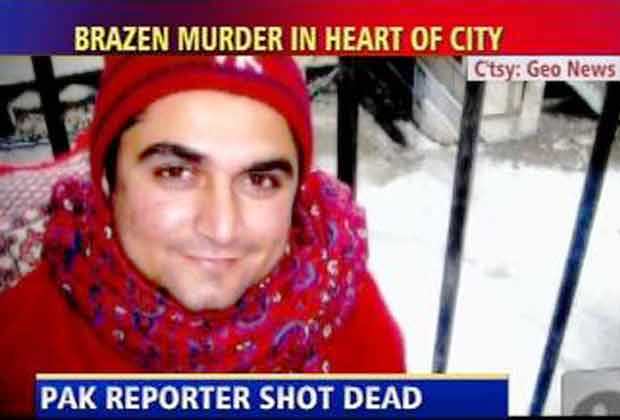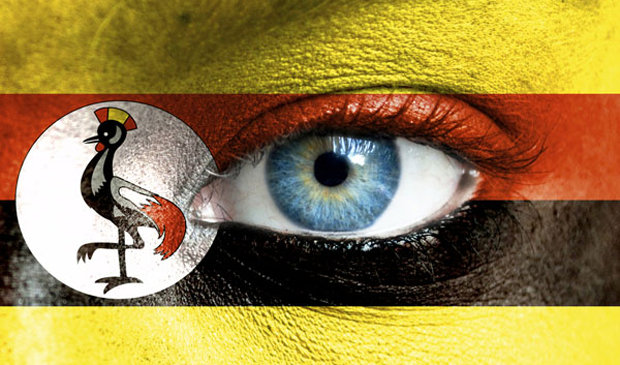10 Mar 2014 | News and features, Uncategorized

(Image: GEO TV)
On 1 March an anti-terrorism court in Pakistan, found six men guilty of the murder of 28-year old journalist Wali Khan Babar. Four have been sentenced to life imprisonment, and two, in absentia, were sentenced to death.
The young reporter was shot dead on January 1, 2011, while working for GEO TV in the Liaquatabad area of Karachi. According to Committee to Protect Journalists, his was a work-related murder.
Convictions for attacks on journalists can be complicatd in Pakistan. Ahmed Omar Saeed Sheikh, who was convicted for the murder of US reporter, Daniel Pearl is the only previous journalist killer to have been sentenced to death. However, Pearl’s case remains in dispute and Sheikh has been incarcerated at the Hyderabad Central Jail for the last 12 years. His lawyers are appealing the conviction, saying he was framed. The confusion arose after Khalid Sheikh Mohmmad (currently being held in Guantanamo) confessed to the murder.
Therefore, Mazhar Abbas, former secretary general of the Pakistan Federal Union of Journalists (PFUJ) while terming this month’s conviction as an “important decision” remains sceptical that Babar’s family will get justice given the abysmally low conviction rate once the case goes to higher courts. “It may take years to get a decision if the case goes to the Sindh High Court for appeal,” he said pointing to deep-rooted “corruption” that prevailes in the judicial system.
But that is not the only reason for the delay in justice. Despite setting up anti-terrorist courts (ATCs) for speedy disposal of cases, the conviction rate has not made an appreciable difference. People like former prosecutor general of Sindh province, Shahadat Awan, links the high rate of acquittal (almost 73 percent), to weak investigation and witnesses retreating.
Since Babar’s trial began, six witnesses, a lawyer and two policemen linked to the investigation have been assassinated.
After these murders, and amid threats to the prosecutors and lawyers, the trial was shifted from Karachi to another city in Sindh, Shikarpur. “The case has been tried under extremely difficult circumstances and to that extent I am satisfied,” acknowledged Abbas.
However, not everyone is wholly satisfied.
According to Zohra Yusuf, chairperson of the independent Human Rights Commission of Pakistan (HRCP) “justice has not been fully served as two culprits are absconding and six witnesses and a prosecution lawyer were killed while the case was being heard.”
For Ambreen Agha, research assistant with New Delhi’s Institute for Conflict Management, the conviction was a welcome step but ensuring justice was equally important.
“It is a significant step in a place where a culture of impunity dominates” she said, citing the example of Malik Ishaq, a militant leader, who, despite his involvement in the massacre of minority Shias and his association with the defunct terrorist outfit, Lashkar e Jhangvi, “goes scot free”.
At the same time, a recent attack on the Islamabad courthouse showed how vulnerable those delivering justice were.
“Despite the threat that looms large on any functioning institution of Pakistan, the judiciary will have to stand strong and determined in bringing justice in this case. The onus lies on the judiciary despite the precarious times in Pakistan,” Agha emphasized.
Nevertheless, for the media community, the conviction of Babar’s killers is historic.
Media analyst, Adnan Rehmat, said the verdict was a “turning point in the battle for defence of beleaguered media practitioners” and Abbas termed it a “ray of hope” showing that Pakistan can improve its record on protecting journalists and pursuing their killers.
But Ambreen Agha warned that a sustained policy was required to “protect the media from the extreme intolerance of the militants and the political class”.
Further, she added: “The political lobby and its attempts to shrink spaces for freedom of expression by shutting down private TV channels, intimidating and blocking certain media outlets, has, in the past, emboldened the terrorists and opened the spaces for the perpetrators of violence.”
This article was posted on March 10, 2014 at indexoncensorship.org
10 Mar 2014 | Awards, Events

International Freedom of Expression 2014 Arts Award Nominee and renowned Turkish playwright and novelist Meltem Arikan will answer your questions via @MeltemArikan on Wednesday 12th March from 14:00 – 14:30 GMT – follow the whole conversation at @IndexCensorship.
In 2013, the Gezi Park protests saw a venting of frustration by many against what they see as the increasingly authoritarian rule of Prime Minister Erdogan’s AK party.
The protests were preceded by the run of Meltem Arikan’s play ‘Mi Minor’ in Istanbul from December 2012 to April 2013. Mi Minor used role play and social media to tell the story of a pianist using technology to struggle against the regime in a fictional land called Pimina. In the month after the play ended, protests erupted in Gezi Park with social media playing a key role.
Arikan, already a prominent writer, found herself accused of fomenting rebellion and faced a co-ordinated campaign of abuse online from government supporters. She told Index on Censorship: “When I was researching for Mi Minor [in 2011] I did everything I could so that the play wasn’t associated with Turkey, or the particular situation of Turkish politics, or any other actual country. It was a fictional dystopia. Mi Minor is an absurd play and it is too worrying to see how absurdity can be accused of being responsible for the reality of what happened in Gezi Park.”
Forced to flee because of the resulting pressures, Meltem Arikan now lives in the United Kingdom.
This event takes place on Wednesday 7 March at 2pm GMT. Tweet your questions @MeltemArikan, join the conversation @IndexCensorship and have your say with the hashtags #MeltemArikan and #IndexAwards2014.
10 Mar 2014 | Africa, News and features, Uganda

(Photo illustration: Shutterstock)
Uganda’s recently passed Anti-Pornography Act 2014 is believed to have led to targeting of women wearing mini-skirts, prompting the cabinet to review the law.
Prime Minister Amama Mbabazi told parliament recently that it is not the duty of the public but the police to implement the law: “The law is not about the length of one’s dress or skirt. As cabinet, we are going to look at the act again.”
The law, assented to by President Yoweri Museveni on 6 February this year, creates and defines the offence of pornography and its prohibition. It bans anyone from producing, trafficking, publishing, broadcasting, procuring, importing exporting or abetting any form of pornography.
Nowhere in the law is a ban on mini-skirts mentioned. The prime minister said that the term “indecent” as defined in the act to mean “non conformity with generally accepted standards” is too broad and varies from one person to another. “It’s very important that the law is clear and specific. I request the public not to take the law in their hands. It’s criminal, especially to women; they must be fully protected, and we shall protect them,” he said.
Initially, the bill proposed the prohibition of types of dress that exposed different body parts like breasts, thighs, genitalia and buttocks, but that clause was deleted before it was enacted into law. The law that was ultimately passed targets media organisations, Internet Service Providers (ISP’s), the entertainment and leisure industry and others putting what is deemed pornographic material into the public domain. Despite this, many women are afraid of the consequences of the law.
The apparent misunderstanding of the law by the public has generally been blamed on Ethics and Integrity Minister Simon Lokodo, who has suggested that it will ultimately help in the fight against indecent dressing by women. He has openly stated that “if a woman is dressed in attire that irritates the mind and excites other people of the opposite sex, you are dressed in wrong attire, so please you should hurry up and go home and change.” He maintains that women should “dress decently” because “men are so weak that if they saw an indecently dressed woman, they would just jump on her”. It should be noted that this minister is a former priest of the Catholic Church.
The act defines pornography as any cultural practice, radio or television programme, writing, publication, advertisement, broadcast, upload on the internet, display, entertainment, music, dance, picture, audio or video recording, show, exhibition or any combination of these that depicts a person engaged in explicit sexual activities or conduct; sexual parts of a person; erotic behaviour intended to cause sexual excitement or any indecent act or behaviour tending to corrupt morals.
The act also proposes setting up a Pornography Control Committee to, among other things, ensure that perpetrators of pornography are apprehended and prosecuted, and to collect and destroy all pornographic materials.
Ruth Ojiambo Othieno, the Executive Director of Isis-Women’s International Cross Cultural Exchange said she was disappointed that the law is targeting women and their bodies.
Miria Matembe, a woman’s activist and former ethics minister argues that the law is very vague and compares it to former President Idi Amin’s directive that women should not wear skirts and dresses more than three inches above the knee.
In a statement, police spokesperson Judith Nabakooba warned that if one suspects a person to be indecently dressed, they should report the matter to police but not take the law into their own hands. “Anyone found participating in mob justice of undressing people and are caught will be dealt with accordingly,” she said.
This article was posted on March 10, 2014 at indexoncensorship.org
10 Mar 2014 | Awards, News and features, Yemen

Yemeni journalist Abdulelah Haider Shaye has produced critical investigative reports on the US military’s activities in Yemen, including drone attacks. He also accessed and interviewed members of Al-Qeada. For this he was smeared as an Al-Qaeda supporter, and held in a Yemeni jail for three years at the request of the American government.
No evidence has ever been produced by either the US or Yemeni Government to support the claim that Shaye was facilitating Al-Qaeda attacks. Shaye indicated the real reason behind his detention was his reporting on US strikes and specifically the deaths of civilians including 14 women and 21 children killed in a sea-launched cruise missile strike on the village of al-Majala in December 2009. Leaked diplomatic cables released shortly after after the conclusion of his trial confirmed Sahye’s accusations that the US had indeed carried out the al-Majala bombing.
Sentenced in January 2011 to five years in prison for allegedly being a “media man for al-Qaeda’, Shaye should have walked free a month later following a presidential pardon. However, the American government stepped in and his release was continuously delayed – once after Barack Obama personally expressed concerns about his scheduled release in a phone conversation with then-president Ali Abdullah-Saleh.
In addition to his arrest, Shaye has been attacked by regime forces. In 2010 he was abducted by Political Security Organisation [PSO] gunmen, and beaten and threatened before being released. His house was also raided by Yemen’s elite US-trained and funded counter terrorism troops and he was allegedly again beaten and tortured during 34 days in solitary confinement, with no access to a lawyer or family members.
Shaye was released from prison in July 2013, to serve the rest of his sentence under house arrest. He has remained steadfast in his commitment to journalism and free speech throughout his imprisonment.
Nominees: Advocacy | Arts | Digital Activism | Journalism
Join us 20 March 2014 at the Barbican Centre for the Freedom of Expression Awards
This article was posted on March 10, 2014 at indexoncensorship.org




